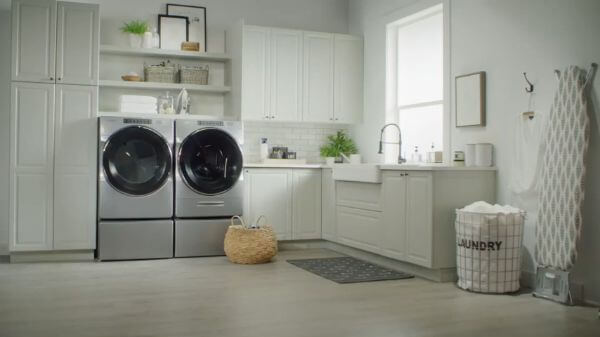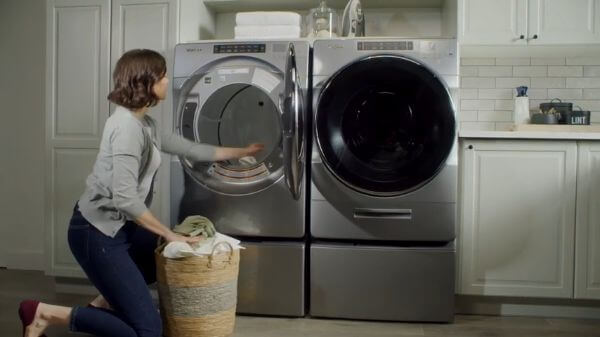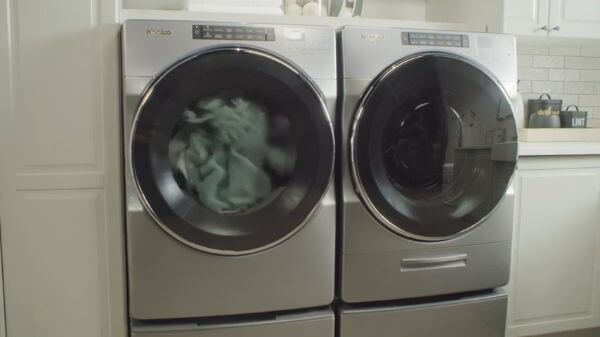Are you in the market for a dryer?
Today’s dryers are powerful, efficient and loaded with features to take care of your clothing, linens and towels.
Our dryer buying guide covers what to consider when shopping for an appliance that can keep up with your laundry needs, installation space and life style.
Let’s talk dryers.
Typically when choosing a dryer, the things to consider are:
- space and budget
- types of dryers
- configuration and capacity
- performance features
- installation
Let’s take a look at each.
Table of Contents
Space and Budget
Start by thinking about your laundry room.
Washer & dryer pairs can be installed in one of two ways, either side by side or stacked.
Setting up your laundry room with the washer and dryer side by side is a common choice and great if you have adequate floor space.
If you choose front loading machines, you can put pedestals underneath for easy loading and unloading.
A side by side set up typically requires at least 54 inches of space across the room, if each machine is the common siizes of 27 inches wide.
Consult dryer’s installation instructions to confirm its minimum required space.
Try mapping out your planned laundry room setup by placing painter’s tape on the floor.
Assess the functionality of this setup before making your purchase.
If space is at a premium, such as in a condo or apartment, consider a stacked front load washer and dryer.
In this setup. the dryer is mounted above the washer. shrinking the footprint of your laundry duo. given the typical 27 inch width of a washer or dryer-
You can install a stacked set in the smallest of spaces, even a closet.
Another planning consideration is price. There’s a dryer for every budget from basic to premium.
Dryer prices vary based on their features, which can include larger capacity or wi-fi connectivity.
You can purchase a dryer on its own. Did you that buying a washer & dryer pair together could save you money?
You’ll also end up with a laundry duo that’s optimized to one another for style and performance.
Types of Dryers
Now let’s look at the main types of dryers, gas dryers and electric dryers.
Both gas and electric dryers are available in top load and front load matching options.
Gas powered dryers heat up fast, resulting in a shorter drying time. They must connect to a gas line in the home. Always hire a certified gas technician when installing gas appliances.
By comparison, electric dryers don’t require gas lines to work, although they do take a little bit longer to warm up, which means drying times can be a little bit longer too.
Electric dryers may or may not require an exhaust vent to be installed through an exterior wall.
Vented machines must vent to the outdoors. which limits where you can install them. They’re generally not an option for apartments and condos.
If you live in an apartment or condo, look for a ventless dryer which can be installed wherever you want.
Ventless models are only available in front load matching machines however.
When buying a ventless dryer, you’ll choose between a heat pump or condensing dryer.
A heat pump recycles the air to dry a load. It takes a bit more time but it reduces energy use.
A condensing dryer utilizes water condensation drying technology to get close dry.
Both types of dryers will dry your laundry equally dry. They just generate heat differently.
Now that we’ve talked a bit about the planning considerations that go into choosing the right dryer for your home, let’s get into the essentials – configuration, capacity and features.
Configuration & Capacity
All dryers load from the front, but some are called top load dryers. That’s because they are meant to coordinate with the top loading washing machine with regards to button placement and overall design.
While all dryer doors are placed in the front of the machine, they can differ in how they open.
Side swing doors swing open to the right or left. Some models are fixed, while others can be reversed to suit your laundry room layout.
Side swing doors provide easy access to the drum or interior of the machine. They also let you place a laundry basket right underneath the open drums so you can unload with ease.
Hamper doors are sturdy and designed to keep clothes from falling onto the floor.
Because they open outwards rather than to the right or left, they are versatile choice for many laundry room layouts.
The door can also double as a surface for folding your freshly clean clothes.
For many household, size and capacity are deciding factors when choosing a dryer.
The average top or front load dryers dimensions are height of 38 to 43 inches, a width of 27 inches and a depth of 28 to 34 inches.
Capacity refers to how much laundry a dryer’s drum can hold. The smaller the drum sizes, the less laundry per load. More capacity means larger loads.
But more capacity also increases the dryer’s price point and space requirements.
Large families often choose a larger appliance with the average capacity ranging from 7 to 7.4 cubic feet.
Smaller households or those who live in condos or apartments may prefer a smaller dryer thatt can fit a tight space. These dryers have an average capacity of 3.4 to 4.3 cubic feet, including the ventless models.
When space is a really at a premium, another option worth considering is an all in one washer & dryer.
This combination appliance does it all. It’s ventless and can be tucked into a bathroom or closet for hassle free space savvy laundry.
If this option sounds good to you, consider Whirlpool’s smart all in one washer and dryer. Not only does it save you space, it helps you do laundry in fewer steps.
Remember, consider your installation space and lifestyle needs when picking the right dryer for your home.
Performance and Features
Most dryers come with a variety of features. The key is finding the right combination to increase efficiency and optimize performance for your family’s needs.
Let’s take a look at some top features worth considering.
Steam cycles use water and heat to release wrinkles without rewashing. This process can also help eliminate odors and lighter stains.
The wrinkle release setting periodically tumbles the load at the end of the cycle, often with no heat, to help keep wrinkles from setting. This occasional tumbling continues for 30 to 90 minutes, depending on the dryer model.
Select Whirlpool dryers have a wrinkle shield plus option with steam. This feature uses tumbling and steam for up to 115 minutes after the cycle ends for improved wrinkle prevention.
Sanitize cycles use extra hot drying temperatures to eliminate a high percentage of common household bacteria.
Select Whirlpool dryers have a sanitize cycle that removes up to 99.9 percent of 3 common household bacteria.
If a dryer doesn’t have to sanitize setting, you can still help eliminate germs simply by using its warmest temperature setting.
Many modern dryers have a moisture sensor to monitor inside moisture and air temperature. Instead of ending the cycle after a set time, the dryer uses this feedback to end the cycle when the load is optimally dry.
Select Whirlpool dryers have this feature. It uses 3 sensors to help prevent over-drying.
Smart appliances help you stay connected and in control from anywhere. Wi-fi connected washers and dryers can help you do your laundry even when you’re away from home.
Whirlpool offer smart dryers that enable you to set and start the dry cycle, pause it to remove delicate items and track progress when you’re away via the Whirlpool app.
Plus with Whirlpool smart dryers you can use a Google assistant enabled device to send voice comands to your dryer, no matter what you’ve got on your hands.
These days many consumers are concerned about energy conservation. Consider energy star certified dryer if you want uncompromised performance, paired with energy efficiency.
Energy star certified dryers are smart choice if your household does a lot of laundry. You can help shrink your energy use and your utility bill too.
Installation
Now that we’ve covered many of the purchase considerations around choosing a dryer, let’s take a look at one final consideration – installation.
The installation of a ventless electric dryer it’s pretty straightforward. Because there is no external vent, you can place it anywhere in your home, provided there is adequate air flow around the appliance. Connected to electrical power via 3 or 4 pronged outlet.
If you choose a vented dryer, set up is a bit more involved. The vent must connect to a part which must be connected to an approximately 4 inch hole through an exterior wall.
You may already have a vent hole in your laundry space, so be sure to check.
Although installing a vented dryer doesn’t require a certified technician, you may prefer the convenience and peace of mind of hiring a pro.
A gas dryer however must always be installed by a certified gas technician. So be sure to factor the extra time and cost into your timeline and budget.
Always refer to your dryer’s installation guide and consult with the professional you are working with.
The right dryer can help you care for your family’s clothes and make laundry day easier.
Look for a dryer that meets your family’s lifestyle needs, budget and laundry space.
We hope you found this dryer buying guide helpful as you plan your dryer purchase.



